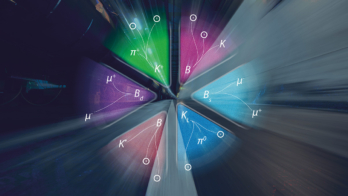
At a CERN seminar on 13 June, the LHCb collaboration presented the world’s most precise measurements of two key parameters relating to CP violation. Based on the full LHCb dataset collected during LHC Runs 1 and 2, the first concerns the observable sin2β while the second concerns the CP-violating phase φs – both of which are highly sensitive to potential new-physics contributions.
CP violation was first observed in 1964 in kaon mixing, and confirmed among B mesons in 2001 by the e+e– B-factory experiments BaBar and Belle. The latter enabled the first measurements of sin2β and were a vital confirmation of the Standard Model (SM). In the SM, CP violation arises due to a complex phase in the Cabibbo–Kobayashi–Maskawa mixing matrix, which, being unitary, defines a triangle in the complex plane: one side is defined to have unit length, while the other two sides and three angles must be inferred via measurements of certain hadron decays. If the measurements do not provide a consistent description of the triangle, it would hint that something is amiss in the SM.
The measurement of sin2β, which determines the angle β in the unitarity triangle, is more difficult at a hadron collider than it is at an e+e– collider. However, the large data samples available at the LHC and the optimised design of the LHCb experiment have enabled a measurement that is twice as precise as the previous best result from Belle. The LHCb team used decays of B0 mesons to J/ψ K0S, which can proceed either directly or by first oscillating into their antimatter partners. The interference between the amplitudes for the two decay paths results in a time-dependent asymmetry between the decay-time distributions of the B0 and B0. The amplitude of the oscillation, and thus the magnitude of CP violation present, is a measurement of sin2β for which LHCb finds a value of 0.716 ± 0.013 ± 0.008, in agreement with predictions.
Based on an analysis of B0S → J/ψ K+K– decays, LHCb also presented the world’s best measurement of the CP-violating phase φs, which plays a similar role in B0S meson decays as sin2β does in B0 decays. As for B0 mesons, a B0S may decay directly or oscillate into a B0S and then decay. CP violation causes these decays to proceed at slightly different rates, manifesting itself as a non-zero value of φs due to the interference between mixing and decay. The predicted value of φs is about –0.037 rad, but new-physics effects, even if also small, could change its value significantly.
A detailed study of the angular distribution of B0S decay products using the Run 1 and 2 data samples enabled LHCb to measure this decay-time-dependent CP asymmetry φs = -0.039 ± 0.022 ± 0.006 rad. Representing the most precise single measurement to date, it is consistent with previous measurements and with the SM expectation. The precision measurement of φs is one of LHCb’s most important goals, said co-presenter Vukan Jevtic (TU Dortmund): “Together with sin2β, the new LHCb result marks an important advance in the quest to understand the nature and origin of CP violation.”
With both results currently limited by statistics, the collaboration is looking forward to data from the current and future LHC runs. “In Run 3 LHCb will collect a larger data sample taking advantage of the new upgraded LHCb detector,” concluded co-presenter Peilian Li (CERN). “This will allow even higher precision and therefore the possibility to detect, through these key quantities, the manifestation of new-physics effects.”
Further reading
LHCb Collab. 2023 LHCb-PAPER-2023-013.
LHCb Collab. 2023 LHCb-PAPER-2023-016.





